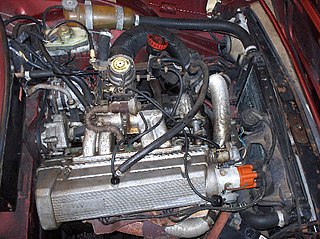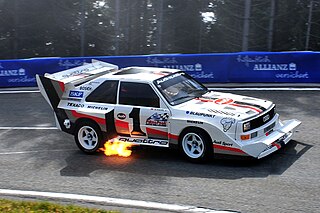Development
The mechanism by which exhaust emissions are controlled depends on the method of injection and the point at which air enters the exhaust system, and has varied during the course of the development of the technology.
The first systems injected air very close to the engine, either in the cylinder head's exhaust ports or in the exhaust manifold. These systems provided oxygen to oxidize (burn) unburned and partially burned fuel in the exhaust before its ejection from the tailpipe. There was significant unburned and partially burned fuel in the exhaust of 1960s and early 1970s vehicles, and so secondary air injection significantly reduced tailpipe emissions. However, the extra heat of recombustion, particularly with an excessively rich exhaust caused by misfiring or a maladjusted carburetor, tended to damage exhaust valves and could even be seen to cause the exhaust manifold to incandesce.
As emission control strategies grew more sophisticated and effective, the amount of unburned and partially burned fuel in the exhaust stream shrank, and particularly when the catalytic converter was introduced, the function of secondary air injection shifted. Rather than being a primary emission control device, the secondary air injection system was adapted to support the efficient function of the catalytic converter. The original air injection point became known as the upstream injection point. When the catalytic converter is cold, air injected at the upstream point burns with the deliberately rich exhaust so as to bring the catalyst up to operating temperature quickly. Once the catalyst is warm, air is injected to the downstream location — the catalytic converter itself — to assist with catalysis of unburned hydrocarbons.
Methods of implementation
Pumped air injection
Pumped air injection systems use a vane pump called the air pump, AIR pump, or colloquially "smog pump" turned by the engine via a belt or electric motor. The pump's air intake is filtered by a rotating screen or the vehicle air filter to exclude dirt particles large enough to damage the system. Air is delivered under light pressure to the injection point(s). A check valve prevents exhaust forcing its way back through the air injection system, which would damage the pump and other components.
Carbureted engines' exhaust raw fuel content tends to spike when the driver suddenly releases the throttle. To prevent the startling and potentially damaging effects of the explosive combustion of this raw fuel, a diverter valve is used. This valve senses the sharp increase in the intake manifold vacuum resulting from the sudden closure of the throttle, and diverts the air pump's outlet to atmosphere. Usually this diverted air is routed to the engine air cleaner or to a separate silencer to muffle objectionable pump noise.
Aspirated air injection
Air injection can also be achieved by taking advantage of the negative pressure pulses in the exhaust system at engine idle. A sensitive reed valve assembly called the aspirator valve is placed in the air injection pumping, which draws its air directly from the clean side of the air filter. During engine idle, brief but periodic negative pressure pulses in the exhaust system draw air through the aspirator valve and into the exhaust stream at the catalytic converter. This system, marketed as Pulse Air, was used by American Motors, Chrysler, and other manufacturers beginning in the 1970s. The aspirator provided advantages in cost, weight, packaging, and simplicity compared to the pump. Also, since there is no pump requiring engine power, parasitic losses associated with the pump are eliminated. However, the aspirator functions only at idle and so admits significantly less air within a significantly narrower range of engine speeds compared to a pump. This system is still used on modern motorcycle engines, e.g. the Yamaha AIS (Air Injection System).

A carburetor is a device used by a gasoline internal combustion engine to control and mix air and fuel entering the engine. The primary method of adding fuel to the intake air is through the Venturi tube in the main metering circuit, though various other components are also used to provide extra fuel or air in specific circumstances.

In internal combustion engines, exhaust gas recirculation (EGR) is a nitrogen oxide (NOx) emissions reduction technique used in petrol/gasoline, diesel engines and some hydrogen engines. EGR works by recirculating a portion of an engine's exhaust gas back to the engine cylinders. The exhaust gas displaces atmospheric air and reduces O2 in the combustion chamber. Reducing the amount of oxygen reduces the amount of fuel that can burn in the cylinder thereby reducing peak in-cylinder temperatures. The actual amount of recirculated exhaust gas varies with the engine operating parameters.

A catalytic converter is an exhaust emission control device which converts toxic gases and pollutants in exhaust gas from an internal combustion engine into less-toxic pollutants by catalyzing a redox reaction. Catalytic converters are usually used with internal combustion engines fueled by gasoline or diesel, including lean-burn engines, and sometimes on kerosene heaters and stoves.
Vehicle emissions control is the study of reducing the emissions produced by motor vehicles, especially internal combustion engines.
The GM Ecotec engine, also known by its codename L850, is a family of all-aluminium inline-four engines, displacing between 1.4 and 2.5 litres. Confusingly, the Ecotec name was also applied to both the Buick V6 Engine when used in Holden Vehicles, as well as the final DOHC derivatives of the previous GM Family II engine; the architecture was substantially re-engineered for this new Ecotec application produced since 2000. This engine family replaced the GM Family II engine, the GM 122 engine, the Saab H engine, and the Quad 4 engine. It is manufactured in multiple locations, to include Spring Hill Manufacturing, in Spring Hill, Tennessee, with engine blocks and cylinder heads cast at Saginaw Metal Casting Operations in Saginaw, Michigan.

Power Stroke, also known as Powerstroke or PowerStroke, is the name used by a family of diesel engines for trucks produced by Ford Motor Company and Navistar International for Ford products since 1994. Along with its use in the Ford F-Series, applications include the Ford E-Series, Ford Excursion, and Ford LCF commercial truck. The name was also used for a diesel engine used in South American production of the Ford Ranger.
An oxygen sensor (or lambda sensor, where lambda refers to air–fuel equivalence ratio, usually denoted by λ) or probe or sond, is an electronic device that measures the proportion of oxygen (O2) in the gas or liquid being analysed.

An inlet manifold or intake manifold is the part of an internal combustion engine that supplies the fuel/air mixture to the cylinders. The word manifold comes from the Old English word manigfeald and refers to the multiplying of one (pipe) into many.
Lean-burn refers to the burning of fuel with an excess of air in an internal combustion engine. In lean-burn engines the air–fuel ratio may be as lean as 65:1. The air / fuel ratio needed to stoichiometrically combust gasoline, by contrast, is 14.64:1. The excess of air in a lean-burn engine emits far less hydrocarbons. High air–fuel ratios can also be used to reduce losses caused by other engine power management systems such as throttling losses.
Manifold vacuum, or engine vacuum in an internal combustion engine is the difference in air pressure between the engine's intake manifold and Earth's atmosphere.

A backfire or afterburn is combustion or an explosion produced by a running internal combustion engine that occurs in the exhaust system, rather than inside the combustion chamber. It is also sometimes referred to as an afterfire, especially in cases where the word backfire is used to mean a fuel burn that occurs while an intake valve is open, causing the fire to move backward through the system and out through the intake instead of the exhaust. When the flame moves backward it may also be called a "pop-back". A backfire can be caused either by ignition that happens with an exhaust valve open or unburnt fuel making its way into the hot exhaust system. A visible flame may momentarily shoot out of the exhaust pipe. A backfire is often a sign that the engine is improperly tuned.

A diesel particulate filter (DPF) is a device designed to remove diesel particulate matter or soot from the exhaust gas of a diesel engine.

A crankcase ventilation system (CVS) removes unwanted gases from the crankcase of an internal combustion engine. The system usually consists of a tube, a one-way valve and a vacuum source.
A throttle is a mechanism by which fluid flow is managed by constriction or obstruction.
The following outline is provided as an overview of and topical guide to automobiles:

Electronic Diesel Control is a diesel engine fuel injection control system for the precise metering and delivery of fuel into the combustion chamber of modern diesel engines used in trucks and cars.
The BMW M56 is a 2.5 liter 184 PS straight-six engine. It is a re-engineered version of the BMW M54B25 engine, manufactured in order to meet SULV regulations in US states until 2006. The M56 was replaced by the BMW N54 which was BMW's first mass-produced turbocharged petrol engine.

An internal combustion engine is a heat engine in which the combustion of a fuel occurs with an oxidizer in a combustion chamber that is an integral part of the working fluid flow circuit. In an internal combustion engine, the expansion of the high-temperature and high-pressure gases produced by combustion applies direct force to some component of the engine. The force is typically applied to pistons, turbine blades, a rotor, or a nozzle. This force moves the component over a distance, transforming chemical energy into kinetic energy which is used to propel, move or power whatever the engine is attached to.
This page is based on this
Wikipedia article Text is available under the
CC BY-SA 4.0 license; additional terms may apply.
Images, videos and audio are available under their respective licenses.









